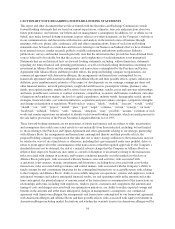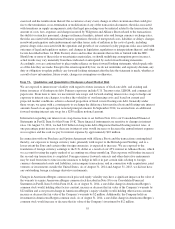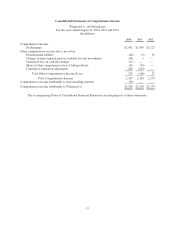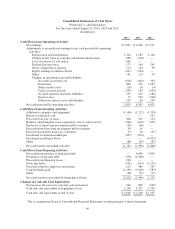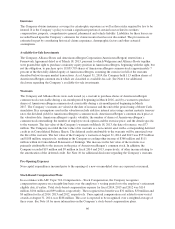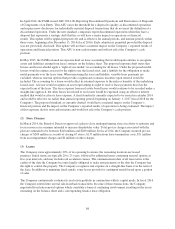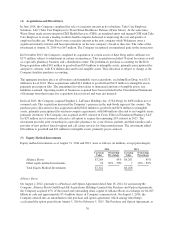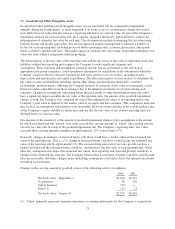Walgreens 2014 Annual Report Download - page 72
Download and view the complete annual report
Please find page 72 of the 2014 Walgreens annual report below. You can navigate through the pages in the report by either clicking on the pages listed below, or by using the keyword search tool below to find specific information within the annual report.Depreciation expense for property and equipment was $923 million in fiscal 2014, $894 million in fiscal 2013
and $841 million in fiscal 2012.
The Company capitalizes application stage development costs for significant internally developed software
projects, such as upgrades to the store point-of-sale system. These costs are amortized over a five-year period.
Amortization expense was $111 million in fiscal 2014, $100 million in fiscal 2013 and $70 million in fiscal
2012. Unamortized costs at August 31, 2014 and August 31, 2013, were $410 million and $374 million,
respectively.
Goodwill and Other Intangible Assets
Goodwill represents the excess of the purchase price over the fair value of assets acquired and liabilities
assumed. The Company accounts for goodwill and intangibles under ASC Topic 350, Intangibles – Goodwill and
Other, which does not permit amortization, but requires the Company to test goodwill and other indefinite-lived
assets for impairment annually or whenever events or circumstances indicate impairment may exist.
Impaired Assets and Liabilities for Store Closings
The Company tests long-lived assets for impairment whenever events or circumstances indicate that a certain
asset may be impaired. Store locations that have been open at least five years are reviewed for impairment
indicators at least annually. Once identified, the amount of the impairment is computed by comparing the
carrying value of the assets to the fair value, which is based on the discounted estimated future cash flows.
Impairment charges included in selling, general and administrative expenses were $167 million in fiscal 2014,
primarily resulting from the Company’s store optimization plan. Impairment charges recognized in fiscal 2013
and 2012 were $30 million and $27 million, respectively.
The Company also provides for future costs related to closed locations. The liability is based on the present value
of future rent obligations and other related costs (net of estimated sublease rent) to the first lease option date. The
reserve for store closings, including $137 million from locations closed under the Company’s optimization plan,
was $257 million as of August 31, 2014 compared to $123 million as of August 31 2013. See Note 2 for
additional disclosure regarding the Company’s reserve for future costs related to closed locations.
Financial Instruments
The Company had $151 million and $197 million of outstanding letters of credit at August 31, 2014 and 2013,
respectively, which guarantee the purchase of foreign goods, and additional outstanding letters of credit of $259
million and $263 million at August 31, 2014 and 2013, respectively, which guarantee payments of insurance
claims. The insurance claim letters of credit are annually renewable and will remain in place until the insurance
claims are paid in full. Letters of credit of $9 million and $4 million were outstanding at August 31, 2014, and
August 31, 2013, respectively, to guarantee performance of construction contracts. The Company pays a facility
fee to the financing bank to keep these letters of credit active. The Company had real estate development
purchase commitments of $169 million and $185 million at August 31, 2014 and 2013, respectively.
The Company uses interest rate swaps to manage its interest rate exposure associated with some of its fixed-rate
borrowings. At August 31, 2014, the Company had $1 billion of fixed-rate debt swapped to floating designated
as fair value hedges. The Company also manages its interest rate exposure associated with its anticipated debt
issuance. In fiscal 2014, the Company entered into a series of forward starting interest rate swap transactions
locking in the then current three-month LIBOR interest rate on $1.5 billion of anticipated debt issuance. These
forward starting swap transactions are designated as cash flow hedges. The Company’s fair value and cash flow
hedges are accounted for according to ASC Topic 815, Derivatives and Hedging, and measured at fair value in
accordance with ASC Topic 820, Fair Value Measurement and Disclosures. See Notes 10 and 11 for additional
disclosure regarding financial instruments.
64


